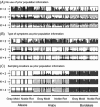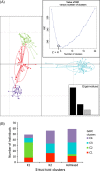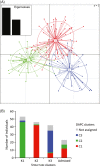The 'Dr Jekyll and Mr Hyde fungus': noble rot versus gray mold symptoms of Botrytis cinerea on grapes
- PMID: 24062804
- PMCID: PMC3779096
- DOI: 10.1111/eva.12079
The 'Dr Jekyll and Mr Hyde fungus': noble rot versus gray mold symptoms of Botrytis cinerea on grapes
Abstract
Many cryptic species have recently been discovered in fungi, especially in fungal plant pathogens. Cryptic fungal species co-occurring in sympatry may occupy slightly different ecological niches, for example infecting the same crop plant but specialized on different organs or having different phenologies. Identifying cryptic species in fungal pathogens of crops and determining their ecological specialization are therefore crucial for disease management. Here, we addressed this question in the ascomycete Botrytis cinerea, the agent of gray mold on a wide range of plants. On grape, B. cinerea causes severe damage but is also responsible for noble rot used for processing sweet wines. We used microsatellite genotyping and clustering methods to elucidate whether isolates sampled on gray mold versus noble rot symptoms in three French regions belong to genetically differentiated populations. The inferred population structure matched geography rather than the type of symptom. Noble rot symptoms therefore do not seem to be caused by a specific B. cinerea population but instead seem to depend essentially on microclimatic conditions, which has applied consequences for the production of sweet wines.
Keywords: Ascomycete; Botrytis cinerea; genetic structure; gray mold; microsatellites; noble rot; population structure.
Figures




References
-
- Agapow P-M, Burt A. Indices of multilocus linkage disequilibrium. Molecular Ecology Notes. 2001;1:101–102.
-
- Bucheli E, Gautschi B, Shykoff JA. Differences in population structure of the anther smut fungus Microbotryum violaceum on two closely related host species, Silene latifolia and S. dioica. Molecular Ecology. 2001;10:285–294. - PubMed
-
- Choquer M, Fournier E, Kunz C, Levis C, Pradier J-M, Simon A, Viaud M. Botrytis cinerea virulence factors: new insights into a necrotrophic and polyphageous pathogen. FEMS Microbioly Letters. 2007;277:1–10. - PubMed
LinkOut - more resources
Full Text Sources
Other Literature Sources

